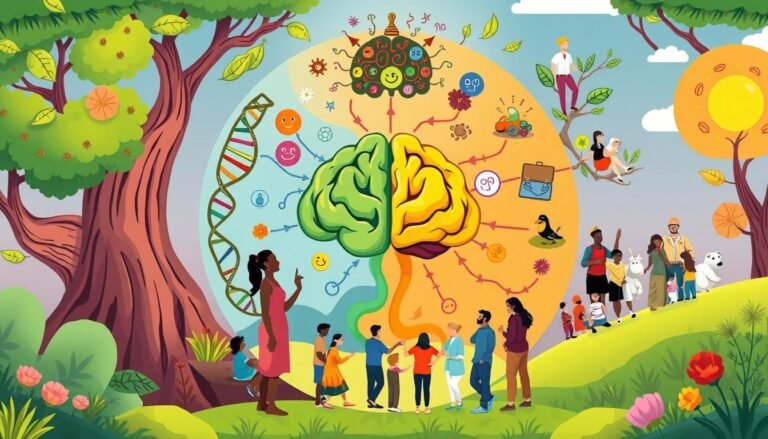Cognitive Processing Therapy (CPT): Healing Trauma
Can a therapy for PTSD really heal deep trauma wounds? Cognitive Processing Therapy (CPT) offers hope to those dealing with trauma’s aftermath. It’s a powerful therapy that helps people process traumatic experiences and take back their lives.
CPT was developed in the late 1980s and is now a key part of trauma treatment. It usually takes 12 weekly sessions, each lasting 60 to 90 minutes. The U.S. Departments of Veterans Affairs and Defense say CPT is a top choice for PTSD treatment, showing its power to change lives.
CPT stands out because it focuses on changing negative beliefs about trauma. It tackles issues like safety, trust, and control. This therapy is for those affected by trauma, from combat to natural disasters. It’s given one-on-one or in groups, offering a way to heal.
Understanding Cognitive Processing Therapy (CPT)
Cognitive Processing Therapy (CPT) is a proven way to help people overcome trauma. It works by changing negative thoughts and beliefs caused by traumatic events.
Definition and Origins
Patricia Resick and her team created CPT to treat post-traumatic stress disorder (PTSD). It’s a 12-week therapy, with each session lasting about an hour. You can do it one-on-one, in a group, or a mix of both, depending on what works best for you.
Core Principles
CPT’s main goal is to help people change harmful thoughts linked to their trauma. It focuses on areas like safety, trust, and self-esteem. These are all affected by traumatic experiences.
- Safety
- Trust
- Power and control
- Self-esteem
- Intimacy
Through special techniques, patients learn to rethink their beliefs about traumatic events. This helps reduce symptoms and improves their daily life.
Target Conditions
Originally made for PTSD, CPT also helps with other trauma-related issues. Studies show it can greatly reduce symptoms like anger and fear. It also helps with emotional numbness, sadness, and shame.
| Symptom | Improvement |
|---|---|
| Anger | Significant reduction |
| Fear | Decreased intensity |
| Emotional numbness | Improved emotional regulation |
| Sadness | Alleviated depressive symptoms |
| Shame | Reduced negative self-perception |
CPT works for many types of trauma and helps a wide range of people. It’s a powerful tool in the fight against trauma and its effects.
The Science Behind CPT: How It Works
Cognitive Processing Therapy (CPT) is a powerful way to deal with trauma. It helps people change negative thoughts linked to their traumatic experiences. This therapy aims to help patients understand their trauma in a new way, reducing its impact on their daily lives.
CPT usually involves 12 weekly sessions, each lasting 60 to 90 minutes. Therapists use Socratic questioning and other methods to help patients question negative thoughts. They work on areas like emotional intimacy, trust, self-esteem, and control, which are often affected by trauma.
Studies show CPT is effective in treating PTSD. A 2019 analysis of 11 studies found CPT helps reduce PTSD symptoms. In 2018, a review showed CPT offers lasting benefits. The American Psychological Association recommends CPT for PTSD treatment.
“CPT works by helping patients create a new narrative around their traumatic experiences, leading to reduced symptoms and improved quality of life.”
Even though CPT is successful, trauma impacts people differently. Some might need more than the usual 12 weeks. Therapists adjust the therapy to meet each patient’s needs, ensuring the best experience for trauma processing.
The CPT Treatment Process
Cognitive Processing Therapy (CPT) is a structured way to heal from trauma. It takes 12 sessions to guide patients on a journey of self-discovery and healing. Let’s look at the main steps in this transformative process.
Initial Assessment and Psychoeducation
CPT starts with a detailed assessment to understand the patient’s trauma history. Therapists then teach about PTSD, showing how thoughts and emotions work together. This knowledge helps patients understand the therapy’s basics.
Identifying and Challenging Unhelpful Thoughts
Patients learn to recognize “automatic thoughts” that worsen PTSD symptoms. They write an impact statement about how the traumatic event changed their beliefs. Therapists use Socratic questioning to help patients change these unhelpful thoughts, a crucial step in managing anxiety.
Written Trauma Accounts
Some CPT methods include writing about the worst traumatic experience. This optional step helps break the pattern of avoiding thoughts and feelings related to trauma, similar to exposure therapy.
Cognitive Restructuring Techniques
CPT teaches patients to identify and tackle stuck points – beliefs that block recovery. Through practice assignments and in-session work, patients learn to challenge and change these beliefs, promoting healthier thinking.
CPT can be given one-on-one, in groups, or through telehealth, making it flexible for different needs. Its effectiveness in reducing PTSD symptoms makes it a valuable tool in trauma recovery.
Cognitive Processing Therapy (CPT) vs. Other PTSD Treatments
Cognitive Processing Therapy (CPT) is a top choice for treating PTSD. It focuses on changing negative thoughts and beliefs linked to the traumatic event. This makes it different from therapies that often require detailed recall of the trauma.
Research supports CPT’s success. It has shown to greatly reduce PTSD symptoms in many people. CPT has even been translated into 12 languages and works well with interpreters or online sessions.
One big plus of CPT is its shorter treatment time. It usually takes about 12 sessions, which is quicker than some other PTSD treatments. Despite its brevity, CPT is highly effective. The APA and VA recommend it as a first choice for PTSD treatment.
A big study compared CPT to Prolonged Exposure therapy. Both were found to be effective, with CPT having fewer patients drop out. While PE showed slightly better results, the difference was not big enough to matter. This shows CPT is a good choice for treating PTSD because it works well and keeps patients engaged.
Effectiveness of CPT in Treating PTSD
Cognitive Processing Therapy (CPT) is a top choice for treating Post-Traumatic Stress Disorder (PTSD). It has been well-studied and proven effective. Many mental health experts recommend it for its success in helping patients.
Research Findings and Success Rates
Research shows CPT beats other treatments in reducing PTSD symptoms. At the end of treatment, CPT users show a big improvement. They do better than 89% of those not getting CPT. This advantage lasts, with studies showing a lasting effect size of 0.90.
Long-term Benefits of CPT
CPT’s benefits don’t stop at PTSD. It also helps with other mental health issues. People see improvements right after treatment and even later. The treatment works well for people of all ages and in different settings.
Populations That Benefit Most from CPT
CPT works best for veterans and those who have survived sexual assault or natural disasters. It usually takes 8-14 sessions. Most people see a big drop in their PTSD symptoms after finishing.
| Population | PTSD Prevalence | CPT Effectiveness |
|---|---|---|
| General Population | 8.3% (lifetime) | 89% improvement post-treatment |
| Military Population | 8.0% (lifetime) | Significant reduction in symptoms |
| Trauma Survivors | 10-20% develop PTSD | 82% improvement at follow-up |
These results highlight CPT’s effectiveness in treating PTSD. It’s a key therapy for many people, showing its value across different groups.
What to Expect During CPT Sessions
Cognitive Processing Therapy (CPT) sessions last 60 to 90 minutes. They happen weekly for about 12 weeks. In the first few meetings, your therapist will check your PTSD and explain CPT.
You’ll learn about managing anxiety and start to identify thoughts that might be holding you back. This is the beginning of your journey.
As you move forward, you’ll do cognitive restructuring exercises. These help you change negative beliefs about your trauma. You might write about your experiences, but it’s not always required.
Don’t worry if talking about your trauma makes you uncomfortable. It’s normal and usually brief.
Each session builds on the last, with homework to help you remember what you’ve learned. By the fourth or fifth session, many people start to feel better. CPT is a structured way to deal with specific traumas, like combat or abuse.
In the final sessions, you’ll look at how trauma has affected your life. You’ll set goals for the future and learn how to keep moving forward. While CPT can be tough, most people find the benefits are worth it.
Source Links
- Cognitive Processing Therapy (CPT)
- VA.gov | Veterans Affairs
- VA.gov | Veterans Affairs
- What Is Cognitive Processing Therapy (CPT)?
- Cognitive Processing Therapy (CPT)
- Cognitive processing therapy: Definition, uses, and more
- Trauma Therapy: How Cognitive Processing Therapy Can Help
- Cognitive Processing Therapy (CPT) | Center for Deployment Psychology
- Cognitive Processing Therapy for Posttraumatic Stress Disorder via Telehealth: Practical Considerations During the COVID‐19 Pandemic
- VA.gov | Veterans Affairs
- Comparison of Prolonged Exposure vs Cognitive Processing Therapy for Treatment of Posttraumatic Stress Disorder Among US Veterans: A Randomized Clinical Trial
- Treating PTSD: A Review of Evidence-Based Psychotherapy Interventions
- A meta-analytic review of cognitive processing therapy for adults with posttraumatic stress disorder – PubMed
- VA.gov | Veterans Affairs
- Angela Hathaway, M. Ed., LCMHC, LPC, NCC
Trauma & Perinatal Specialist - Cognitive processing therapy (CPT)








